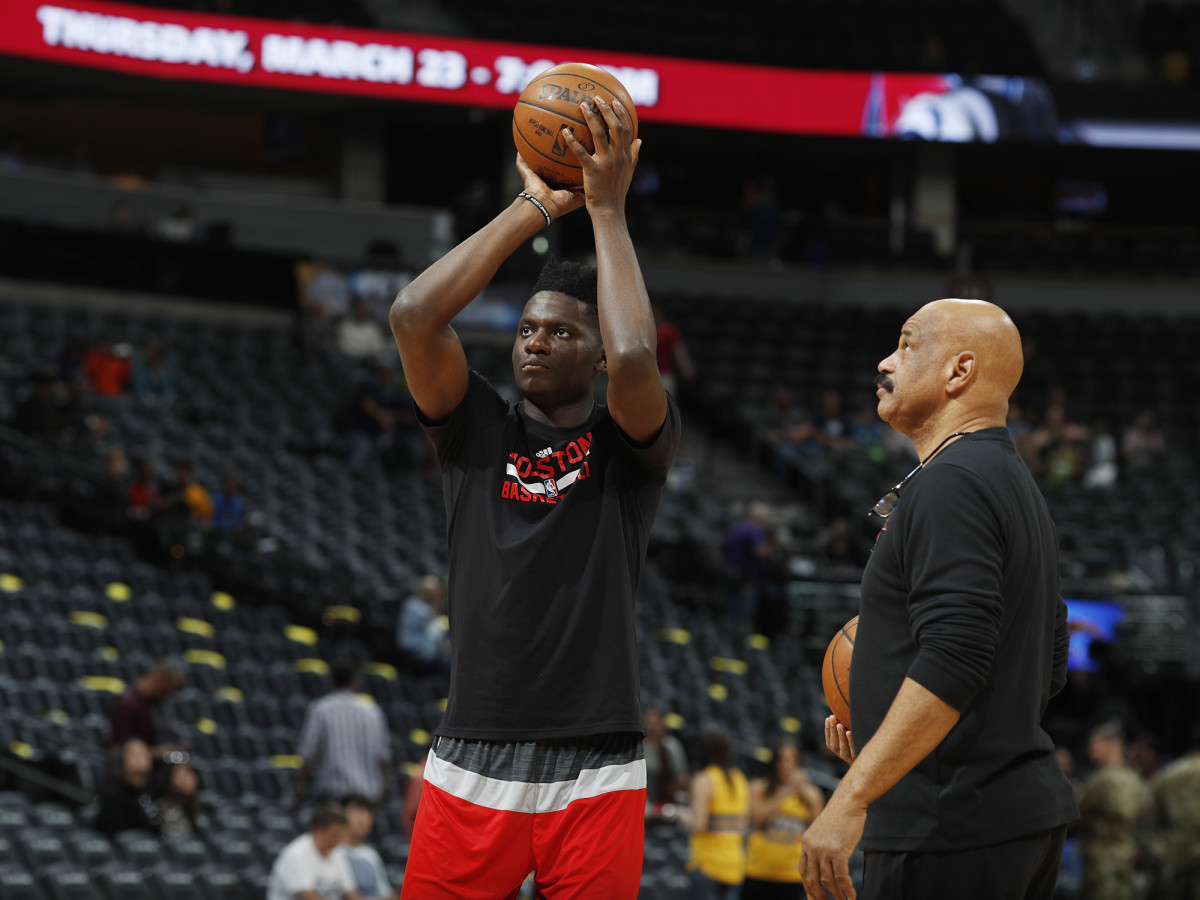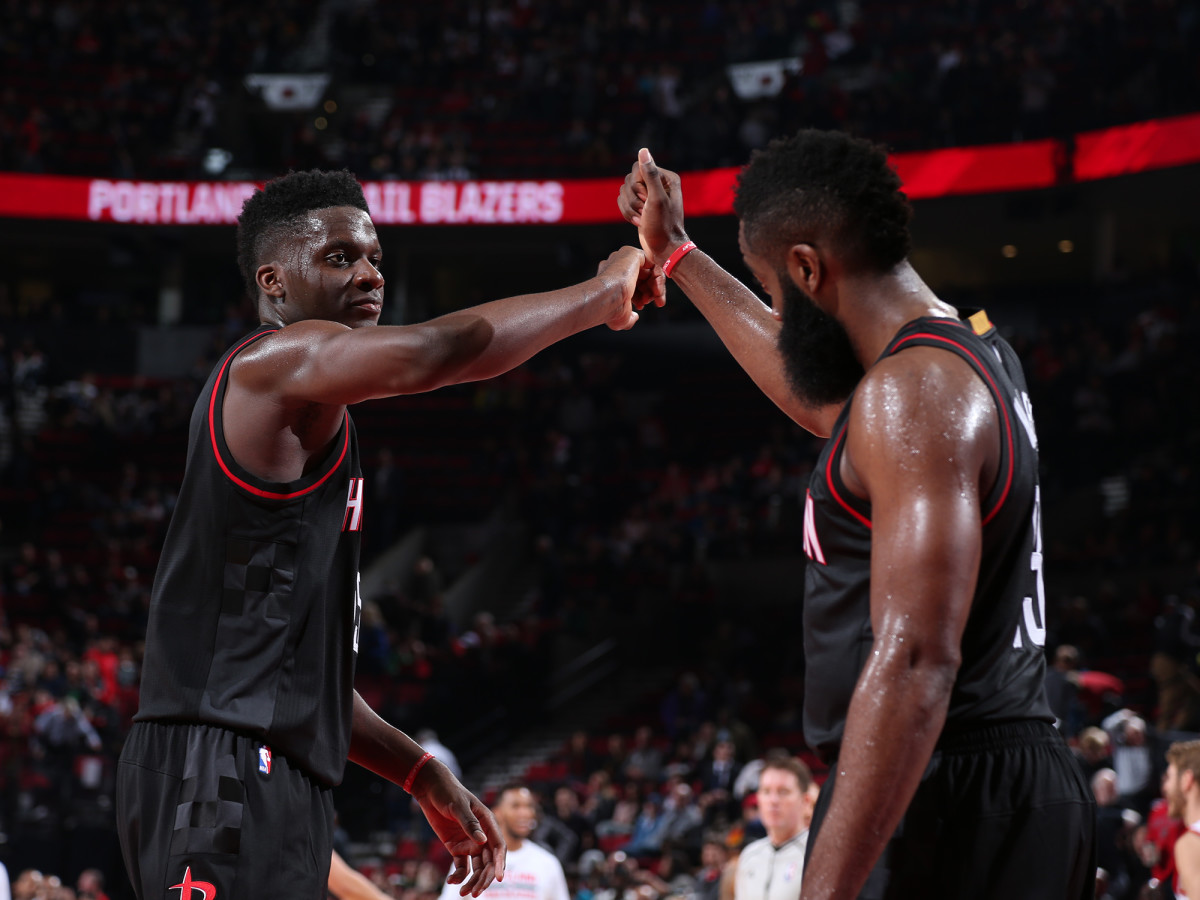The People And Places That Made Clint Capela

Clint Capela and John Lucas stepped out into the drizzle. The Rockets’ starting center may as well have been another New York skyscraper, his 6’10" frame shielding the Houston assistant coach while they awaited an Uber back from Barclays Center to the team’s hotel in downtown Manhattan. On this Sunday morning in January, Capela is still two days away from returning to the court following a small left fibula fracture that sidelined him for 15 games.
The team bus had long since departed following the Rockets’ morning shootaround. The duo lagged behind to loft extra jumpers and free throws. Rehab is a mere blip in Capela’s evolution into James Harden’s symbiotic lob partner. Lucas, after all, forfeited his day-to-day role in the John Lucas Wellness and Aftercare Program to lead the Rockets’ player development. With alcohol and substance abuse derailing his own NBA career—which the Rockets launched by selecting the Maryland product No. 1 overall in 1976—Lucas scripted a second act as a hybrid personal trainer and life coach, draft prospects and NBA stars alike seeking his gospel.
2017 NBA Big Board 4.0: As Draft Picture Gets Clearer, De'Aaron Fox's Stock Rises
Capela’s the strapping specimen a development staffer dreams of: a reservoir of athleticism, a frame practically begging to be sculpted with muscle, an inherent understanding of the sport. Near 7-foot, 22 year-olds of that makeup are rarer than desert rain, and his recent history of rapid skill maturation only compounds the Rockets’ excitement. Lucas is the unique lifer equally qualified for hardwood tutelage and off-court inspiration. Capela might just be the pupil he was destined to mentor.

Daryl Morey first observed Capela inside Le Colisée, Chalon’s 5,000-seat arena in eastern France. In a city considered the birthplace of photography, the teenage stringbean could only provide a snapshot of his powers. Foul trouble relegated him to the bench, yet Caplea flashed glimpses of elite ability. “You’re judging athleticism, you’re judging their touch, how they move, how hard they play,” Morey said. Houston’s general manager flew to Geneva the day prior, shuttling two hours across the Switzerland border to attend the game. Morey’s drive virtually traced the path of Capela’s prodigious hoops career.
Capela arrived at Chalon’s INSEP training center in 2009, only two years removed from his first organized basketball game at 13 years old. Romain Chenaud plucked Capela from the Swiss U16 national team trials. The Chalon coach had accompanied one of the program’s junior team players to the event, only to find himself fixated on the gangly wingspan and soft hands of the youngest player on the floor. “When I saw him on the court, I just needed five minutes to think: 'Wow, this kid is the future of our academy and of our pro team,'" Chenaud emailed The Crossover.
Immersion in France’s basketball laboratory accelerated Capela’s maturation, but stalled other aspects of his life. He essentially turned professional at 15 years old, forfeiting the freedom to see his family for months on end. “I knew I had sacrifices to make,” Capela said. Distance, though, was far from a foreign obstacle. Independence has been a theme interwoven as deeply in Capela’s story as basketball. It’s practically a family trait.
The Moments Without Russell Westbrook Are Killing Oklahoma City
His mother immigrated to Switzerland from the Congo by way of Italy. Film lured her from Central Africa to Rome, where the aura of Hollywood on the Tiber still romanced aspiring performers. She met a man along the way, marrying and giving birth to her first son, Fabrice. She followed her husband to Geneva, child in tow, only to split with her first love. She fell for Capela’s Angolan father soon after, bringing her second boy, Landry, into the world. Landry was a toddler when Clint arrived, and that’s when mom had another dance with autonomy. Capela’s father left shortly after the birth of his second son. They’re no longer in touch. He knows little about the man responsible for his life.
For an out-of-work actress twice spurned by a partner, raising three sprouting boys grew an insurmountable responsibility. Child poverty once ran rampant in Switzerland, where, in the 1950s, orphans, illegitimate children and kids from poor families were often given away or sold to farmers as laborers. The country’s modern education system, rippling from its apprenticeship model, has more than resolved that plague. Landry, 10, and Capela, 6, were housed in a welfare orphanage to complete elementary school.
The Pierre Grish house became their home, as they merged into its group of 21 children. They dined together within the large house’s first floor. On the second floor, the kids roomed by two or three. Older students eventually bussed to more advanced schools. After two years, Capela progressed beyond the regular learning curve and began attending a superior school down the road. His body too quickly outpaced his peers. They played ping pong and soccer in the house’s large yard during the afternoons. One boy particularly flourished.
Futbol was his first love. With prolonged strides, Capela would gallop past his friends, beelining for points. “I was a striker. I used to score goals,” he said. His height also proved a vertical asset on the pitch. “Headers, of course.” The night before the Rockets selected Capela with the 25th pick in the 2014 NBA Draft, he chewed his lip watching Switzerland battle past Honduras and advance to the World Cup’s Round of 16.
Crystal Ball: Who Will Win the 2017 NBA Finals?
Every haven does have its flaws. Despite returning to their mother on weekends, Landry grew weary of Pierre Grish’s confined sleeping quarters. His rage boiled to the surface. He lashed out at the educators aiming to quiet the house. “He was really, really powerful for his age,” Capela said. “They were not able to help him calm down.” Landry was expelled from the premises, leaving an 8-year-old Capela to confide in the boys his age. They formed an unwavering bond and would later visit the Rockets center in Houston. The friendships persevered Capela’s departure from the house when he exceeded the 12-year-old age limit.
He entered a new group home, where boys resided before beginning their individual apprenticeships at 15. Animosity and aggression lingered in the new halls, a stark difference from the nurturing environment he had relished. It was easy to manhandle a toothpick preteen uncomfortably growing into his own body. “I was the youngest. I was skinny,” Capela said. “I learned how to deal by myself, because usually my brother was always around and I was protected.”
He followed Landry’s every move after the trying seventh, and final, year in child services. Big brother and friends had begun flirting with basketball and convinced the towering younger Caplea to start playing ball with his hands. They could never have known what stroke of fortune those bouts in the park, attempting to emulate Allen Iverson’s crossover and later idolizing Switzerland’s only NBA player, Thabo Sefolosha, would become. Capela reallocated nearly his entire rookie season salary back home. His mother was unfathomably behind on rent and government payments. “She had taxes to pay for 20 years, so I took care of it,” Capela said. “Taxes from insurance, apartment, social help.” Two decades of debt, wiped away as swiftly as he cleans the glass.

Basketball came easy, reminiscent of another futboler turned Rockets center. Hakeem Olajuwon adapted his eminent Dream Shake from a misdirection tactic he learned playing soccer. “It gives you mobility, it makes you good with your feet,” Morey said. Capela ascended within Chalon’s academy, swiftly achieving each benchmark the staff mandated. He rendered advanced big man development commonplace. He was soon drilled on chasing guards and creating off the dribble. “We even tried to make him play small forward,” Chenaud said. Chalon blinked and Capela lept to the pro team. He began to smell the NBA. He took a taste at the 2014 Nike Hoop Summit and soon hungered for a full bite. “Everything happened really fast,” Sefolosha said.
He feasted on carbs leading up to the NBA draft, moving in with an American handler from his French agency in Dallas, training on-court in the morning and striving to gain weight at the kitchen table. Scouts still expected Capela to bloom overseas for another season. Adding bulk to combat the league’s hulking centers was more necessity than aesthetic. “In my head, I was ready to come,” Capela said. “Even if I wasn’t ready to play right away, I was ready to come and work and learn about the NBA.”
Meeting Markelle Fultz: A Day With The NBA's (Likely) No. 1 Pick
Houston maintained his hearty diet, feeding him before and after practices. “I was eating food all the time,” Capela said. Adding mass still required a balancing act. Capela’s explosive athleticism is what weaponizes his worldly size. “That’s been a big focus: getting him stronger while trying to preserve that,” Morey said. Houston ensconced the youngster in an anaerobic conditioning program, strategically designed to include resistance training and power. He improved his conditioning through a core strength purpose and simulating on-court pushing and pulling against opponents. His body took seamlessly. "Clint is one of the most elite athletes on the planet," said Javair Gillett, Houston’s director of athletic performance.
Capela was an investment. The Rockets had time to groom an idealized modern center while Dwight Howard co-starred with Harden. In the meantime, his contributions enticed Houston’s decision makers. In 75 minutes of Capela anchoring Houston’s preferred small-ball wings last season—Patrick Beverley, Trevor Ariza and Corey Brewer flanking Harden—the Rockets boasted a net rating of 25 points per 100 possessions. “Looking at the information and obviously watching the games,” Morey said. “We felt like he could take that next step.”
Howard’s off-season departure for Atlanta opened the door to unveil Capela’s refinement. He’s tailor-made to pick-and-roll in Mike D’Antoni’s whirring offense, averaging 12.6 points, 8.1 rebounds and 1.2 blocks in just 23.9 minutes per game. His free throw conversion has risen 15.2% with the help of Lucas. Just as the Rockets took off behind Harden’s offensive orchestration, Capela’s aerial threat at the rim and ferocity protecting it has been integral to Houston’s return to contention. “To be the starting center on a 55-win at age 22, that’s an amazing achievement,” Morey said.
These playoffs are Capela’s first true act on this stage. He’s here on his own volition, traversing the world with an orange, leather ball in hand, playing for those who saw him sweat and share his blood.
